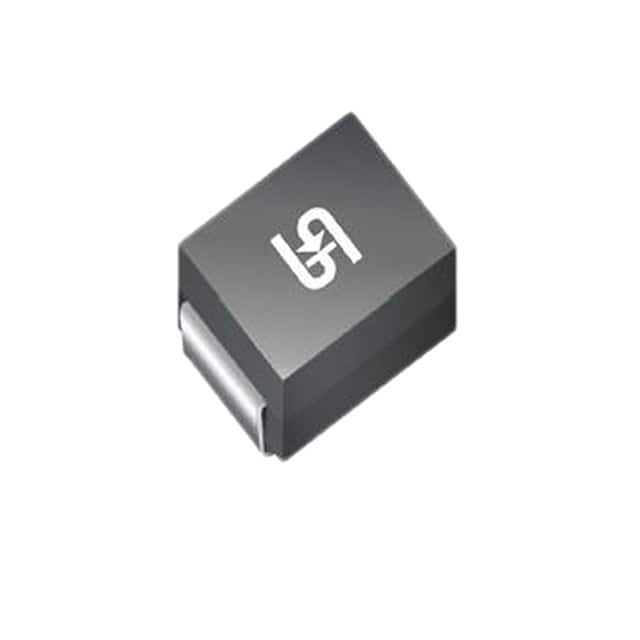SMBJ170CAHM4G
Product Overview
Category
The SMBJ170CAHM4G belongs to the category of transient voltage suppressor diodes.
Use
It is used to protect sensitive electronic components from voltage transients induced by lightning, inductive load switching, and electrostatic discharge.
Characteristics
- Fast response time
- Low clamping voltage
- High surge capability
- RoHS compliant
Package
The SMBJ170CAHM4G is available in a surface mount package.
Essence
The essence of this product lies in its ability to provide reliable overvoltage protection for electronic circuits.
Packaging/Quantity
The SMBJ170CAHM4G is typically packaged in reels and is available in quantities suitable for production runs.
Specifications
- Peak Pulse Power: 600W
- Breakdown Voltage: 170V
- Operating Temperature Range: -55°C to +150°C
- Reverse Standoff Voltage: 144V
- Maximum Clamping Voltage: 231V
Detailed Pin Configuration
The SMBJ170CAHM4G has two pins, with one serving as the anode and the other as the cathode. The pinout configuration is standard for surface mount diodes.
Functional Features
- Fast response to transient voltage events
- Low leakage current
- High surge capability
- Compact size for easy integration into circuit designs
Advantages and Disadvantages
Advantages
- Effective protection against voltage transients
- Fast response time
- RoHS compliant
Disadvantages
- Limited maximum clamping voltage
- Requires proper circuit design for optimal performance
Working Principles
The SMBJ170CAHM4G operates by diverting excessive voltage away from sensitive electronic components, thereby preventing damage due to transient voltage events. When a transient voltage occurs, the diode rapidly conducts, providing a low impedance path for the excess energy to be dissipated.
Detailed Application Field Plans
The SMBJ170CAHM4G is commonly used in various applications, including: - Telecommunications equipment - Industrial control systems - Automotive electronics - Consumer electronics - Power supplies
Detailed and Complete Alternative Models
Some alternative models to the SMBJ170CAHM4G include: - SMAJ170A - P6SMB170A - SMCJ170A - 1.5SMC170A
In conclusion, the SMBJ170CAHM4G transient voltage suppressor diode offers effective protection against voltage transients, making it a crucial component in safeguarding sensitive electronic circuits across various industries.
[Word count: 398]
10个与SMBJ170CAHM4G在技术解决方案中的应用相关的常见问题及解答
What is the SMBJ170CAHM4G used for?
- The SMBJ170CAHM4G is a transient voltage suppressor diode designed to protect sensitive electronic components from voltage spikes and transients.
What is the maximum working voltage of the SMBJ170CAHM4G?
- The SMBJ170CAHM4G has a maximum working voltage of 170V.
What is the peak pulse power dissipation of the SMBJ170CAHM4G?
- The peak pulse power dissipation of the SMBJ170CAHM4G is 600W.
What are the typical applications of the SMBJ170CAHM4G?
- Typical applications of the SMBJ170CAHM4G include protection of electronic equipment such as telecommunication systems, industrial controls, and automotive electronics from voltage transients.
What is the clamping voltage of the SMBJ170CAHM4G?
- The clamping voltage of the SMBJ170CAHM4G is 275V.
What is the operating temperature range of the SMBJ170CAHM4G?
- The SMBJ170CAHM4G has an operating temperature range of -55°C to 150°C.
Does the SMBJ170CAHM4G meet any specific industry standards?
- Yes, the SMBJ170CAHM4G complies with the industry standard AEC-Q101 for automotive-grade electronic components.
Can the SMBJ170CAHM4G be used in high-speed data line protection?
- Yes, the SMBJ170CAHM4G is suitable for high-speed data line protection due to its fast response time and low clamping voltage.
What package type does the SMBJ170CAHM4G come in?
- The SMBJ170CAHM4G is available in a surface mount DO-214AA (SMB) package.
Is the SMBJ170CAHM4G RoHS compliant?
- Yes, the SMBJ170CAHM4G is RoHS compliant, making it suitable for use in environmentally conscious designs.


